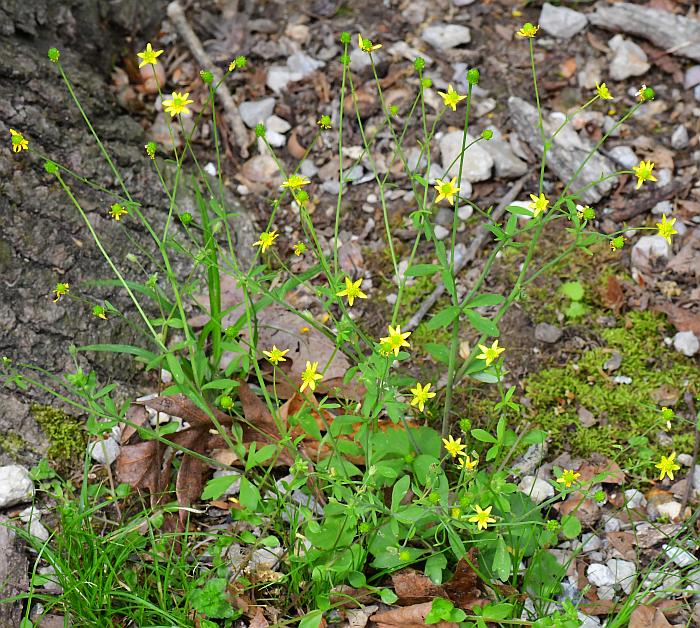Ranunculus harveyi (A. Gray) Britton
Harvey's Buttercup

Native
CC = 7
CW = 3
MOC = 43
© SRTurner
Ranunculus harveyi (A. Gray) BrittonHarvey's Buttercup | |
 |
Native CC = 7 CW = 3 MOC = 43 |
© SRTurner |
|
Family - Ranunculaceae Habit - Perennial forb, with a mixture of thin and fibrous and tuberous-thickened roots.
Stems - Strongly ascending to erect, to 45 cm, sometimes multiple from the base, branching, hollow, glabrous toward the tip, usually with sparse to moderate, more or less spreading hairs toward the base, the base not bulbous-thickened.
Leaves - Basal leaves present at flowering, moderately- to long-petiolate, the petioles to 7 cm long, glabrous. Blades 1-3 cm long, 1.5-3.8 cm wide, more or less kidney-shaped to nearly circular, glabrous, green above, silvery green below, unlobed or occasionally the innermost 3-lobed, the base shallowly to deeply cordate, the margins otherwise finely to coarsely scalloped. Stem leaves with the petiole progressively shorter from base to tip, the lowermost leaves moderately to long-petiolate, those toward the stem tip usually sessile, the blade deeply 3-lobed or-compound, the segments narrowly lanceolate to obovate, the broader ones toothed or narrowly lobed along the margins.
Inflorescence - Open, loose panicles. Pedicels to 2.5 cm long, glabrous. Flowers - Sepals 5, 2-4 mm long, spreading or reflexed from the base but lacking a transverse fold, plane or nearly so. Petals 5-7, 4.0-7.5 mm long, 1.5-3.0 mm wide, narrowly oblong-obovate, longer than the sepals, yellow, usually glossy. Style present. Stamens numerous. Filaments yellow, glabrous. Anthers yellow, 1 mm long.
Fruits - Head of achenes 3-6 mm long at maturity, hemispheric to more or less globose, the receptacle glabrous or very sparsely hairy. Achenes 1.4-1.7 mm long, turgid, green, glabrous, the dorsal margin broadly and bluntly angled, the wall thick, smooth, glabrous, the beak 0.2-0.6 mm long, slender, straight.
Flowering - March - May. Habitat - Rocky upland forests, savannas, bluffs and outcrops, streambanks, roadsides; most abundant on acidic substrates. Origin - Native to the U.S. Lookalikes - Broadly, other species of Ranunculus. Other info. - This little species is found mostly in the southeastern half or Missouri. Elsewhere it also occurs in Arkansas, as well as with diminishing abundance in a few neighboring states. Many species of buttercup look similar, but this one is relatively easy to distinguish by its flowers, which are intermediate in size between those of R. hispidus and those of the crowfoots. Habitat is another good clue, as this plant has a fondness for rocky, acid soils. At least a few unlobed basal leaves will usually be present, whereas the upper stem leaves are divided into straplike segments. Photographs taken in the Piney Creek Wilderness, Mark Twain National Forest, Barry County, MO., 4-4-04 (DETenaglia); also at Tyson County Park, St. Louis County, MO, 4-3-2010 and 5-3-2015, Washington State Park, Washington County, MO, 4-11-2011, and Ha Ha Tonka State Park, Camden County, MO, 4-22-2023 (SRTurner). |